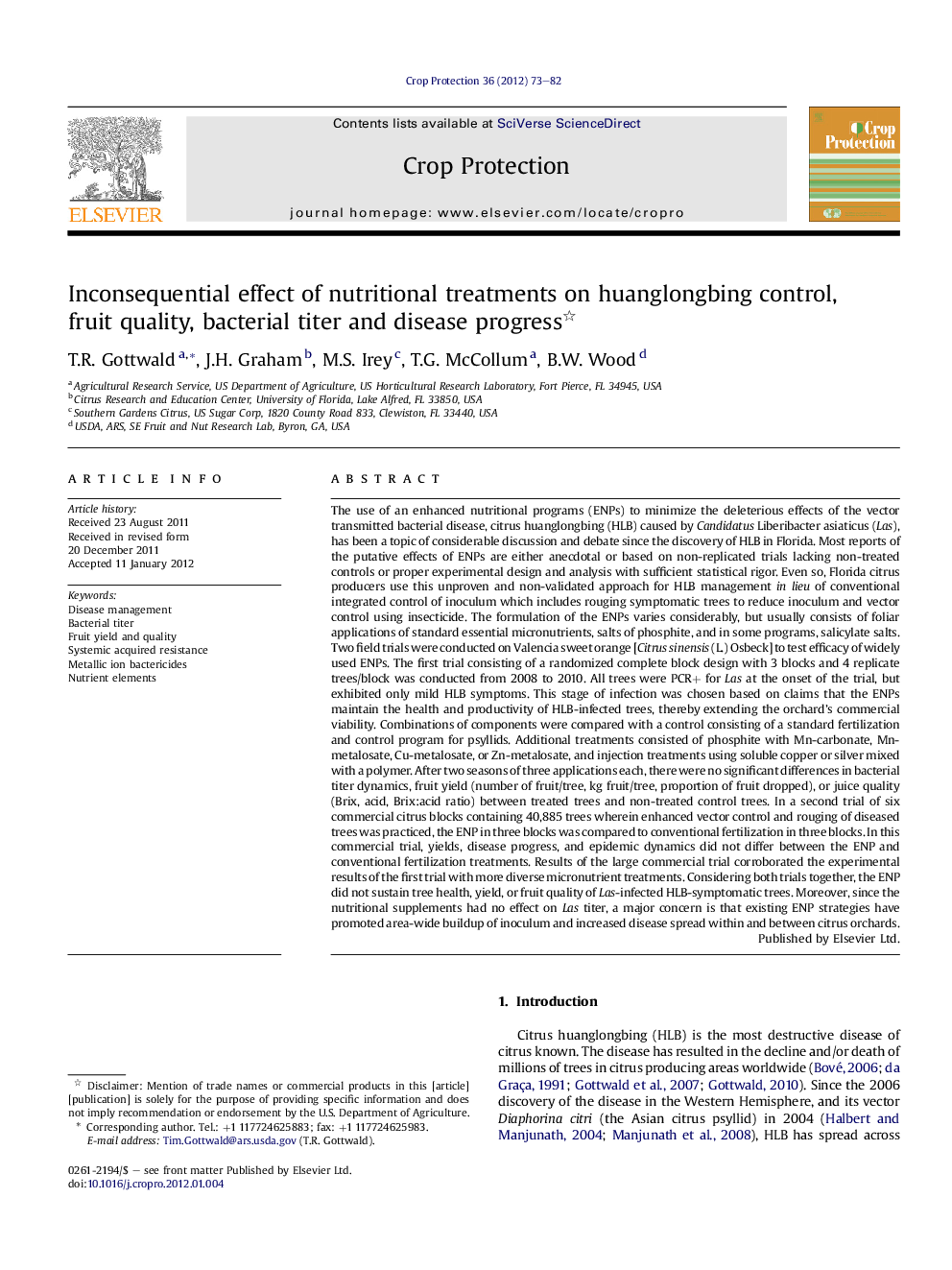| کد مقاله | کد نشریه | سال انتشار | مقاله انگلیسی | نسخه تمام متن |
|---|---|---|---|---|
| 4506480 | 1624351 | 2012 | 10 صفحه PDF | دانلود رایگان |

The use of an enhanced nutritional programs (ENPs) to minimize the deleterious effects of the vector transmitted bacterial disease, citrus huanglongbing (HLB) caused by Candidatus Liberibacter asiaticus (Las), has been a topic of considerable discussion and debate since the discovery of HLB in Florida. Most reports of the putative effects of ENPs are either anecdotal or based on non-replicated trials lacking non-treated controls or proper experimental design and analysis with sufficient statistical rigor. Even so, Florida citrus producers use this unproven and non-validated approach for HLB management in lieu of conventional integrated control of inoculum which includes rouging symptomatic trees to reduce inoculum and vector control using insecticide. The formulation of the ENPs varies considerably, but usually consists of foliar applications of standard essential micronutrients, salts of phosphite, and in some programs, salicylate salts. Two field trials were conducted on Valencia sweet orange [Citrus sinensis (L.) Osbeck] to test efficacy of widely used ENPs. The first trial consisting of a randomized complete block design with 3 blocks and 4 replicate trees/block was conducted from 2008 to 2010. All trees were PCR+ for Las at the onset of the trial, but exhibited only mild HLB symptoms. This stage of infection was chosen based on claims that the ENPs maintain the health and productivity of HLB-infected trees, thereby extending the orchard's commercial viability. Combinations of components were compared with a control consisting of a standard fertilization and control program for psyllids. Additional treatments consisted of phosphite with Mn-carbonate, Mn-metalosate, Cu-metalosate, or Zn-metalosate, and injection treatments using soluble copper or silver mixed with a polymer. After two seasons of three applications each, there were no significant differences in bacterial titer dynamics, fruit yield (number of fruit/tree, kg fruit/tree, proportion of fruit dropped), or juice quality (Brix, acid, Brix:acid ratio) between treated trees and non-treated control trees. In a second trial of six commercial citrus blocks containing 40,885 trees wherein enhanced vector control and rouging of diseased trees was practiced, the ENP in three blocks was compared to conventional fertilization in three blocks. In this commercial trial, yields, disease progress, and epidemic dynamics did not differ between the ENP and conventional fertilization treatments. Results of the large commercial trial corroborated the experimental results of the first trial with more diverse micronutrient treatments. Considering both trials together, the ENP did not sustain tree health, yield, or fruit quality of Las-infected HLB-symptomatic trees. Moreover, since the nutritional supplements had no effect on Las titer, a major concern is that existing ENP strategies have promoted area-wide buildup of inoculum and increased disease spread within and between citrus orchards.
► Enhanced nutritional programs (ENPs) are suggested to control citrus huanglongbing (HLB).
► Two commercial trials examined effects of micronutrients and metallic ions on HLB.
► Pathogen titer and disease dynamics were uncontrolled by ENPs.
► NPs did not maintain citrus yield and quality of HLB-infected trees.
► Use of NPs rather than disease tree removal and vector control spreads HLB disease.
Journal: Crop Protection - Volume 36, June 2012, Pages 73–82